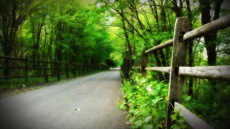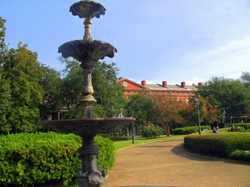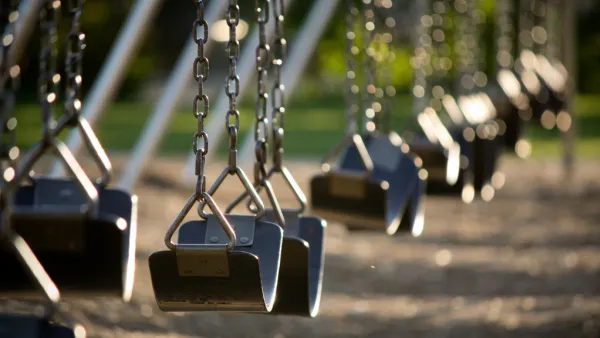A recent Planetizen interview on the relationship between park space and active living got me thinking about what spaces inspire physical activity and what spaces discourage it. In my old apartment complex, the indoor fitness centers were jammed while the nearby riverside walking trails were desolate, despite nearly perfect year-round weather. Why? The trails were perceived as unsafe because they were completely isolated from view.
A recent Planetizen interview on the relationship between park space and active living got me thinking about what spaces inspire physical activity and what spaces discourage it.
In my old apartment complex, the indoor fitness centers were jammed
while the nearby riverside walking trails were desolate, despite nearly
perfect year-round weather. Why? The trails were perceived as unsafe
because they were completely isolated from view.
 I'm somewhat perplexed by the trend in trail building: rail trails,
I'm somewhat perplexed by the trend in trail building: rail trails,
urban greenways, trails through state parks, trails through the woods
and backcountry. These may be ideal for bicyclists or for weekend
hikes with friends. But they are not practical places for solo walkers
and joggers.
Greenways, trails and ill-defined open spaces often don't work as
envisioned because planners fail to consider safety as a paramount
issue, especially for women. Even if crime statistics declare an area safe, it's really the perceived safety that counts. I am simply not
going to step onto a secluded trail (unless, perhaps, it has constant
foot traffic).
 The wilderness-like parks seem to be
The wilderness-like parks seem to be
increasingly emphasized at the expense of smaller community parks that
provide the right facilities for outdoor exercise. One element
overlooked by park planners is the community track or paved walking
loop. In the eastern US, many high school tracks are open to the
public; they tend to be safe and well-used. Out West, school tracks are
unfortunately locked and reserved for student use only. Where school
tracks are not an option, walking loops within parks are a good
alternative. These can be placed around baseball diamonds, soccer
fields, playgrounds and picnic areas.
Because park safety depends largely on visibility, walking loops should
be within the sightline of other park users as well as passersby.
Ideally, the park would offer a diversity of activities that attract
visitors. It would also be large enough for physical activity but not
so expansive that people feel lost.
I'm curious to hear from Planetizen readers about local parks that
encourage active living. What about trails and greenways? Which seem
to be heavily used for recreation and/or transportation? What makes
them work?
Photos:
1) Rail Trail in CT (adwriter/Flickr)
2) Jackson Square, New Orleans (KenSBrown/Flickr)

Analysis: Cybertruck Fatality Rate Far Exceeds That of Ford Pinto
The Tesla Cybertruck was recalled seven times last year.

National Parks Layoffs Will Cause Communities to Lose Billions
Thousands of essential park workers were laid off this week, just before the busy spring break season.

Retro-silient?: America’s First “Eco-burb,” The Woodlands Turns 50
A master-planned community north of Houston offers lessons on green infrastructure and resilient design, but falls short of its founder’s lofty affordability and walkability goals.

Test News Post 1
This is a summary

Analysis: Cybertruck Fatality Rate Far Exceeds That of Ford Pinto
The Tesla Cybertruck was recalled seven times last year.

Test News Headline 46
Test for the image on the front page.
Urban Design for Planners 1: Software Tools
This six-course series explores essential urban design concepts using open source software and equips planners with the tools they need to participate fully in the urban design process.
Planning for Universal Design
Learn the tools for implementing Universal Design in planning regulations.
EMC Planning Group, Inc.
Planetizen
Planetizen
Mpact (formerly Rail~Volution)
Great Falls Development Authority, Inc.
HUDs Office of Policy Development and Research
NYU Wagner Graduate School of Public Service


























